|
|
| Übersicht – Contents: | |
Diese Seite ist Teil des Projektes
|
|
| Übersicht – Contents: | |
Flagge – Flag: |
|
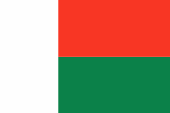 |
Nationalflagge – national flag, Seitenverhältnis – ratio = 2:3, Quelle/Source, nach/by: Flags of the World   |
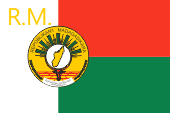 |
Flagge des Präsidenten – Flag of the President, Seitenverhältnis – ratio = 2:3, Quelle/Source, nach/by: Wikipedia (D) |
historische Flaggen – historical Flags: |
|
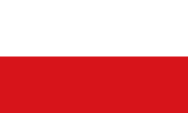 |
1810–1885, Merina-Königreich Madagaskar – Merina-Kingdom of Madagascar, Nationalflagge – national flag, Quelle/Source, nach/by: Flags of the World |
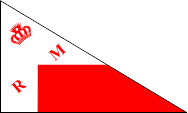 |
1883–1897, Merina-Königreich Madagaskar – Merina-Kingdom of Madagascar, Flagge der Königin – Flag of the Queen, Quelle/Source, nach/by: Flags of the World, Wikipedia (D) |
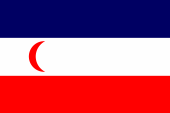 |
1885–1896, Französisches Protektorat Madagaskar – French protectorate of Madagascar, Nationalflagge – national flag, Quelle/Source, nach/by: Flags of the World |
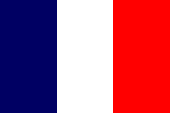 |
1896–1958, Madagaskar ist französische Kolonie – Madagascar is a French colony |
| Die heutige Flagge Madagaskars wurde im Zusammenhang mit der Erklärung der Autonomie erstmals am 21.10.1958 offiziell gehisst. Sie war der Sieger in einem Gestaltungswettbewerb. Als das Land am 26.06.1960 die Unabhängigkeit erreichte, wurde die Flagge beibehalten. Sie zeigt zwei waagerechte Streifen in Rot und Grün, sowie einen senkrechten weißen Streifen am Mast. Alle Streifen sind gleich groß. | The today's flag of Madagascar was officially hoisted for the first time in context with the declaration of autonomy on the 21th December in 1958. It was the winner in a designing competition. As the country on the 26th of June in 1960 achieved the independence this flag was maintained. It shows two horizontal stripes in red and green, as well as a vertical white stripe on the hoist. All stripes have the same dimensions. |
| Den Farben wird heute folgende Bedeutung zugesprochen: Weiß steht für Reinheit und Frieden, Rot steht für Selbstbestimmung und Verteidigungsbereitschaft und Grün steht für die Hoffnung auf eine bessere Zukunft. Die Farben der Flagge werden folgendermaßen angegeben: Rot = Pantone warm red, Grün = Pantone 348. | The
colours should today have the following meaning: White stands for purity and peace, red stands for sovereignty and readiness for defense and green stands for the hope for a better future. The colours of the flag are indicated as follows: Red = warm red, Green = Pantone 348. |
| Die Farben Rot und Weiß leiten sich von Flaggen ab, die im 19. Jahrhundert vom Merina-Reich geführt worden sind, welches damals die ganze Insel beherrschte. Die Merina, die im zentralen Hochland leben, sind in drei Kasten gegliedert: Andriana, Hova und Andevo. Sie sind, wie 98% der madegassischen Bevölkerung, indonesisch-malaiischer Abstammung. Interessant ist, dass auch andere Staaten mit indonesisch-malaiischer Bevölkerung, wie z.B. Indonesien, Malaysia, Westirian, Osttimor, die Molukken, aber auch einige Ozeanische Staaten (z.B. Philippinen) Flaggen mit der Farbkombination Rot-Weiß führen. | The
colours red and white are derived from flags, which were in use by the
Merina Empire in the 19th century, which at that time ruled over the whole
island. The Merina, which live in the central highlands are divided into
three castes: Andriana, Hova und Andevo. They are – like 98% of the Madegassian population – of Indonesian/Malaysian descent. Interesting is, that also other countries with Indonesian/Malaysian population, like Indonesia, Malaysia, West Irian, East Timor, the Molucca Islands, but even some Oceanian countries (e.g.: Philippine Islands) use flags with the combination of the colours red and white. |
| Als Madagaskar französisches Protektorat wurde, hat man der Flagge von Madagaskar oben einen blauen Streifen angefügt, und im weißen Mittelstreifen einen roten Halbmond ergänzt. Auf diese Weise wehten die französischen Farben in waagerechter Anordnung über der Insel. Als die Insel 1896 endgültig französischen Kolonie wurde, durfte – wie bei allen französischen Kolonien – keine eigene Flagge mehr gehisst werden. Es war nur noch die französische Trikolore zu verwenden. | As
Madagascar became a French protectorate they added to the flag of Madagascar
a blue stripe above, and in the white middle stripe a red half-moon. In this way blowed the French colours in horizontal arrangement on the island. As the island in 1896 became ultimately a French colony, it was not allowed to use an own flag – like in all French colonies. Ther was only to use the French tricolor. |
| Beim großen Aufstand des Jahres 1947 tauchten wieder rot-weiße Flaggen auf, so dass es nicht verwunderlich ist, dass am 21.10.1958 – aus Anlass der Erklärung der Autonomie – wieder eine Flagge mit der Kombination von Rot und Weiß angenommen wurde. Jedoch wurde noch Grün für die Küstenbewohner (Betsimisaraka) ergänzt. | During
the big uprising in the year 1947 emerge again red-white flags. It is that's
why not surprising, that on the 21st of October in 1958 – because of the
declaration of the autonomy – was adoped again a flag with the combination
of red and white. But there was added green. It stands for the coastal residents (Betsimisaraka). |
| Quelle/Source: Flaggen und Wappen der Welt, Die Welt der Flaggen, Flaggen Wappen Hymnen, Flags of the World | |
Wappen – Coat of Arms: |
|
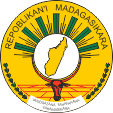 |
seit 1998, Wappen von Madagaskar – coat of arms of Madagascar, Quelle/Source: Corel Draw 4 |
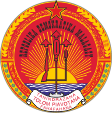 |
1975–1992, Wappen von Madagaskar – coat of arms of Madagascar, Quelle/Source: Corel Draw 4 |
| Das heutige Staatswappen ist eigentlich ein Siegel und wurde im Jahre 1998 eingeführt. Es ist eine Rückbesinnung auf das Wappen der Jahre 1958–1975. | The
today's coat of arms is actually a seal and was introduced in the year 1998. It is a memory to the coat of arms of the years 1958–1975. |
| Es ist eine goldene runde Scheibe und zeigt in der Mitte die Landkarte der Insel auf einer kleineren silbernen Scheibe, dahinter die Wedel des Ravenala-Baumes. Unterhalb der silbernen Scheibe ein Rinderkopf und Reisfelder. Am oberen Rand der Name des Staates: "Repoblikan'i Madagasikara" und am unteren Rand, zwischen zwei Reisähren das Staatsmotto: "Tanidrazana, Fahafahana, Fahamarinana" → "Vaterland, Revolution, Gerechtigkeit". | It is a
golden round disk and shows in the middle the map of the island on a smaller
silvery disk and behind the fronds of the Ravenala Tree. Below the silvery
disk a cow's head and rice fields. On the upper side the name of the state: "Repoblikan'i Madagasikara" and on the lower side the motto of the state between two rice ears: "Tanidrazana, Fahafahana, Fahamarinana" → "Fatherland, Revolution, Justice". |
| Das Stastwappen zwischen 1975 und 1992 war ebenfalls ein rundes Siegel, jedoch war es rot und zeigte in seiner Mitte Gewehr, Spaten und Schreibfeder – zu einem Dreizack vereint – vor einer aufgehenden Sonne, darüber der damalige Staatsname und der rote Stern des Sozialismus. Unterhalb des Dreizacks ein Zahnrad als Symbol der Industrialisierung. Das Motto auf dem Schriftband lautete: "Tanidrazana, Tolom Piavotana, Fahafahana" → "Vaterland, Freiheit, Revolution". | The coat
of arms between 1975 and 1992 was as well a round seal, but it was red and
showed in its middle rifle, spade and writing plume – united to one trident
– in front of a rising sun. Above that the then name of the state and the red star of socialism. Below the trident a sprocket as symbol for industrialization. The motto on the banner was: "Tanidrazana, Tolom Piavotana, Fahafahana" → "Fatherland, Freedom, Revolution". |
| Quelle/Source: Flaggen und Wappen der Welt, Die Welt der Flaggen, Flaggen Wappen Hymnen, Volker Preuß | |
Flugzeugkokarde – aircraft roundel: |
|
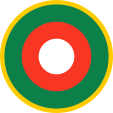 |
Flugzeugkokarde – aircraft roundel Quelle/Source, nach/by: Wikipedia (EN) |
Landkarte – Map: |
Lage – Position: |
Landkarte des Landes – Map of the Country: |
|
|
| Zahlen und Fakten – Numbers and Facts: | |
|
|
|
|
|
|
|
|
|
|
|
|
|
|
|
|
|
|
|
| ca. 2.000
v.Chr. · persische, arabische und melanesische Besiedelung ca. 900 n.Chr. · Einwanderung der malaiischen Merina 1500 · der portugiesische Seefahrer Diego Diaz entdeckt die Insel und landet auf Madagaskar 16. Jhd. · Portugiesen und Franzosen errichten Stützpunkte an der Küste 1642 · Frankreich nimmt die Insel Madagaskar offiziell in Besitz, jedoch gibt es zu diesem Zeitpunkt nur Fort Dauphin (heute: Taolanaro) als Stützpunkt an der Südküste der Insel 1643 · Inbesitznahme der an der Ostküste gelegenen Insel Ste. Marie durch Frankreich, französische Besiedlungsversuche scheitern 1787 · das Merina-Reich dehnt sich über fast ganz Madagaskar aus, vor allem im Norden und Osten der Insel 1810–1828 · Regentschaft des Königs Radama I., weiterer Gebietszuwachs für das Merina-Reich, vor allem im Westen der Insel, Großbritannien erobert einige französische Stützpunkte im Süden der Insel → gute Beziehungen Madagaskars zu Großbritannien 1828–1861 · Regentschaft der Königin Ranavalona I. (Witwe von König Radama I.) 1833 · Inbesitznahme der an der Westküste gelegenen Insel Be (Nosy Be) durch Frankreich 1861–1863 · Regentschaft des Königs Radama II., er wird ermordet 1863–1883 · Regentschaft der Königin Razoherina I. (Witwe von König Radama II.) 1864–1895 · der Premierminister des Merina-Reichs, Rainilaiarivony, versucht den Merina-Staat nach dem Vorbild Japans zu reformieren 1883 · Inbesitznahme der an der Ostküste gelegenen Ortschaft Tamatave (heute: Toamasina) durch Frankreich 1883–1897 · Regentschaft der Königin Ranavalona III. 1885 · Inbesitznahme der an der Nordküste gelegenen Ortschaft Diego Suarez (heute: Antseranana) durch Frankreich, weitere militärische Operationen Frankreichs, vor allem an der Küste 1885 · Frankreich errichtet sein Protektorat über Madagaskar 1895 · Beginn des französischen kolonialen Eroberungskrieges 1896 · Madagaskar wird französische Kolonie 1939–1945 · Zweiter Weltkrieg: Madagaskar untersteht bis 1942 der französischen Regierung in Vichy, britische und südafrikanische Truppen erobern 1942 Madagaskar und unterstellen es der Regierung des Freien Frankreich von General de Gaulle 1946 · Autonomieforderungen 1947 · großer antikolonialer Aufstand, Niederschlagung durch französische Truppen 14.10.1958 · Frankreich gewährt begrenzte Autonomie, Proklamation der Autonomen Republik 26.06.1960 · Unabhängigkeit 1973 · die französischen Truppen verlassen das Land 1990 · Einführung eines wahrhaftigen Mehrparteiensystems 1992 · neue Verfassung 1998 · Verfassungsänderung 2006 · versuchter Militärputsch 2025 · in Folge von Unruhen verlässt der Präsident das Land, das Militär übernimmt die Macht |
|
ca. 2.000
B.C. · Persian, Arabic and Melanesian settlement ca. 900 B.C. · immigration of the Malaysian Merina tribe 1500 · the Portugese seafarer Diego Diaz discovers the island and debarks on Madagascar 16th cent. · Portugese and French establish bases on the coast 1642 · France officially appropriates Madagaskar Island, but there exists at this point in time only Fort Dauphin (nowadays: Taolanaro) as base on the southern coast of the island 1643 · appropriation of the on the eastern coast positioned Ste. Marie Island by France, French attempts for settlement fail 1787 · the Merina Empire expands over nearly whole Madagascar, specially in the north and the east of the island 1810–1828 · regency of the King Radama I., further territorial increase for the Merina Empire, specially in the west of the island, United Kingdom conquers some French bases in the south of the island → good dealings of Madagascars with United Kingdom 1828–1861 · regency of the Queen Ranavalona I. (Widow of King Radama I.) 1833 · appropriation of the on the western coast positioned Be Island (Nosy Be) by France 1861–1863 · regency of the King Radama II., he gets murdered 1863–1883 · regency of the Queen Razoherina I. (Widow of King Radama II.) 1864–1895 · the prime minister of the Merina Empire, Rainilaiarivony, trys to reform the Merina State after the example of Japan 1883 · appropriation of the on the eastern coast positioned place Tamatave (nowadays: Toamasina) by France 1883–1897 · regency of the Queen Ranavalona III. 1885 · appropriation of the on the northern coast positioned place Diego Suarez (nowadays: Antseranana) by France, further military operations by France, specially on the coast 1885 · France establishes its protectorate over Madagascar 1895 · beginning of the French colonial conquesting war 1896 · Madagascar becomes a French colony 1939–1945 · Second World War: Madagascar is subordinated until 1942 to the French government in Vichy, British and South African troops conquer in 1942 Madagascar and subordinate the island to the government of the Free France of General de Gaulle 1946 · claims for autonomy 1947 · great anti-colonial uprising, crushed by French troops 14th of October 1958 · France grants autonomy, proclamation of the autonomous republic 26th of June 1960 · independence 1973 · the French troops leave the country 1990 · introduction of a veritable multi-party-system 1992 · new constitution 1998 · change of the constitution 2006 · attempted military coup 2025 · as a result of riots, the president leaves the country and the military takes power |
| Quelle/Source: Atlas zur Geschichte, Wikipedia (D), Discovery '97 |
| Die Bezeichnung "Madagaskar" ist eigentlich ein von Europäern verwendeter Begriff. Die Einheimischen nennen ihre Insel und den darauf gelegenen Staat gelegentlich wie ihre Sprache: "Malagasy", was "Mondinsel" heißt. Der Begriff "Madagaskar" geht aber trotzdem auf die malaiischen Siedler zurück, welche die Insel wahrscheinlich nach ihrer ursprünglichen Heimat "Macasar" nannten. "Macasar" ist eine Stadt im Süden der Insel Celebes (Sulawesi) im heutigen Indonesien. Allerdings wird sie heute "Ujung Pandang" genannt. | The
designation "Madagascar" is actually a by Europeans used term. The
indigenous people name their island and the on it situated state occasional
like their language: "Malagasy", what means "Moon Island". But the term "Madagascar" derives anyhow back to the Malaysian settlers, which named the island probably like their original homeland "Macasar". "Macasar" is a city in the south of Celebes Island (Sulawesi) in the today's Indonesia. But it is named today "Ujung Pandang". |
| Quelle/Source: Handbuch der geographischen Namen, Volker Preuß | |